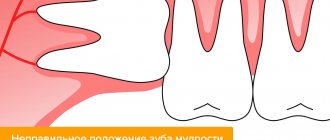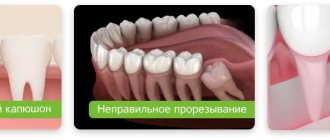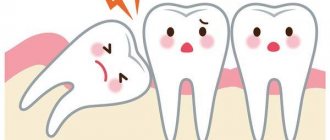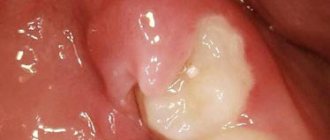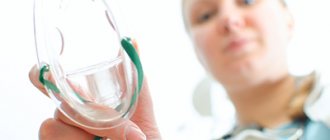Visiting the dentist rarely brings joyful emotions. Many modern dentistry clinics offer dental treatment or tooth extraction using general anesthesia (general anesthesia). What should you consider when considering this dental care option?
Fear of dentists is inherent in every patient, but in some cases the situation becomes uncontrollable and it is simply impossible to remove or treat a tooth in the usual way.
Dental treatment during sleep allows you to effectively carry out most manipulations in the mouth. But it is important to remember the existing limitations, taking into account not only the positive, but also the negative aspects of such therapy.
So is it possible to treat teeth under general anesthesia, using different types of general anesthesia?
Under general anesthesia, a type of anesthesia is offered that helps to completely eliminate the patient’s sensitivity and activity and put him into a medicated sleep.
However, most dentists prefer to carry out sedative therapy before local anesthesia, since it does not require complete exclusion of consciousness, and the patient can respond to the doctor’s voice, calmly perceive manipulations, remain in a relaxed state, while the fear of the appointment has already been eliminated.
The superficial effect of local analgesia eliminates sensation in the oral cavity, but does not allow the patient to relax physically and mentally. If necessary, the situation can be improved by combining sedatives, plunging the patient into a superficial sleeping state; if necessary, the patient can easily emerge from this state.
What types of pain relief are used during tooth extraction?
A classic example of an archaic tooth extraction without any anesthesia is an episode from Chekhov’s story “Surgery.” In modern dentistry, such outright torture does not happen, and tooth extraction without anesthesia is not carried out under any circumstances. If it is necessary to remove 1 - 2 teeth in one visit, the operation is carried out mainly under local anesthesia. However, there are indications for tooth extraction under general anesthesia.
In medicine, the term “general anesthesia” means a state of inhibition of the central nervous system with a temporary immersion of the patient into sleep of varying degrees of depth and loss of pain sensitivity. This reaction of the body is artificially induced using safe anesthetic medications, and it lasts from 30 minutes to 3 hours, depending on the required volume of surgical intervention. For example, removing 4 wisdom teeth under general anesthesia will require a significant amount of time.
Disadvantages of general anesthesia (full general anesthesia)
- There may be a possible presence of individual sensitivity to drugs with the effect of reduced or increased sensitivity or long-term aftereffects from anesthesia with deterioration of health (drowsiness, confusion, dizziness, vomiting);
- The need to carry out additional preparatory measures in the form of a general examination , obtaining an ECG 5 hours before the anesthesia procedure is to be performed, avoiding eating three hours before visiting the dentist, and should not consume alcoholic beverages.
- The high speed of work of a dentist in the oral cavity and the associated increased radicalism during manipulations. The doctor’s work time is limited; it is necessary to do all the planned manipulations in the oral cavity; there is not always time for a painstaking search for canals in the roots of the teeth or treatment of teeth in the stage of moderate caries.
- Death of a patient as a result of unexpected general reactions to the administered drug
- To avoid complications of the patient, before performing dental treatment using general anesthesia, it is advisable to examine it in as much detail as possible, especially if you plan to give anesthesia to a child. There is no doubt that these examinations, firstly, sharply reduce the number of patients for whom anesthesia is indicated. After all, if you approach the examination results strictly, many patients will have to be excluded. Secondly, this will lengthen the process of dental treatment; many examination results will have to wait several days from the laboratory. And thirdly, this will further increase the price of the total cost of treatment, which is already quite considerable.
- Such a strict approach is primarily opposed by the patients themselves; few people want to undergo a lot of tests for several days at their own expense; people choose general anesthesia for the sake of speed, in order to cure all their teeth at once.
- However, if unforeseen complications arise, all doctors and patients turn into strict judges and ask with surprise why a detailed examination was not carried out. The truth is that miracles do not happen and any medical intervention has its risks.
- The high cost of general anesthesia is several times higher than the cost of local methods of pain relief due to the need for additional equipment in the clinic and the need to attract an additional anesthesiologist.
- An accompanying person is required to assist a patient after a dental appointment.
Tooth extraction under general anesthesia price, Samara, dental treatment under general anesthesia. Prices for dental treatment under general anesthesia in Samara - price of wisdom teeth removed under general anesthesia where, is it possible to remove teeth under general anesthesia
Immersion of the patient in a state of sleep for 60 minutes allows the following types of work to be performed
- removal of 4-10 teeth (the number depends on the complexity of the procedure);
- removal of 2-4 teeth, characterized by difficult eruption (impacted teeth);
- treatment of 3-5 teeth at the stage of pulpitis (the number is determined by the condition of the roots and canals of the teeth);
- treatment of carious formations up to 5-8;
- installation of dental implants in the required quantity with osteoplasty and sinus lift;
- treatment of periodontitis for up to 3 teeth, depending on the complexity and curvature of the tooth canals.
Teeth under #general anesthesia Samara, wisdom teeth under general anesthesia, #teeth extraction under general anesthesia reviews prices, where to remove teeth under general anesthesia.
Two types of general anesthesia
- Intravenous - injection anesthesia
Today's preference for this option is given by the maximum number of doctors. Special medications that are administered over a specific period of time (the dose is determined by the anesthesiologist).
This method requires appropriate knowledge and experience and can only be performed by a specialist anesthesiologist.
Among the most commonly used drugs are Gekennal, Sombrevin, Calipsool. The patient's condition during the treatment procedure is monitored by an anesthesiologist.
- Inhalation anesthesia
For this type of anesthesia, a special mask is used, through which an anesthetic composition is supplied in a gaseous state - a mixture of gas and oxygen, which enters directly into the respiratory tract, quickly being absorbed into the blood. Nitric oxide, fluorotane, is used as the main anesthetic drug.
Also, during inhalation anesthesia, an intubation tube is used to deliver a general anesthetic.
It is difficult to act as an independent expert in a field of medicine in which you do not practice regularly. However, long experience in surgical dentistry has made it possible to use immersion of patients into medicinal sleep at the reception. At one time, the appointment was carried out at a hospital with the assistance of an anesthesiologist, so it was possible to observe in practice all the features of general anesthesia in dentistry.
First of all, it is necessary to distinguish between premedication drugs and anesthetic drugs. If the first ones can be purchased using a simple recipe. the latter are difficult to acquire, and most importantly, it is difficult to account for their use. The medical institution has many problems with taking them into account; many have seen reports in the press about criminal cases filed against dentists or veterinarians. What should a poor operational worker do if, when checking, he sees that according to the magazine there should be three ampoules of the drug in stock, but there are only two available. In fact, one ampoule went somewhere else, and this is a criminal offense.
Therefore, dentists often use a complex drug mixture for premedication instead of a single drug for general anesthesia. These combinations are officially prescribed in textbooks, they may well be an alternative to general anesthesia, they give almost the same effect. This form of premedication is an excellent solution for a dental appointment, except for two disadvantages.
- Complex combinations of drugs are difficult to control and produce pronounced aftereffects. Most often, they have a strong inhibitory effect and can depress breathing and cardiac activity. Combinations may contain atropine, which is very undesirable.
- The presence in the pharmacopoeia of excellent drugs for raush anesthesia, recommended specifically for short-term outpatient interventions in dentistry, otorhinolaryngology, and gynecology.
An example is midazolam. The drug is little known in Samara, there is almost no experience with its use. Belongs to the group of benzodiazepines, close to tazepam, seduxen. Ultra-fast and ultra-short-acting drug. Provides an excellent level of general immersion with the removal of fear and pain; the patient experiences a superficial pink sleep, allowing the dentist to carry out any intervention slowly and with high quality.
But the main advantage of this drug is that the sleep itself is very superficial, contact with the patient is maintained, the person answers questions, can control his condition and gives signals when it changes, but still sleeps. After completing the treatment, the doctor simply says, “The treatment is over, let’s get up,” and the patient wakes up with a smile. A cup of coffee finally drives away the aftereffect of the drug.
The drug midazolam can be used in tablets and solution; there is no need for intravenous injection. In tablets, the effect occurs within the usual 20 minutes. The uniqueness of the drug is that it can be used intranasally in solution, then the total dose is significantly reduced, and the onset of sleep is sharply accelerated.
But, obviously, today this group of drugs is under very strict control. We do not use strictly controlled drugs, because we are not a hospital and do not have an anesthesiologist on staff.
However, we have a solution for patients with increased fear of visiting the dentist. Oddly enough, you can buy the most powerful sedative drug Novopassit over the counter in a pharmacy. Like any product of the Western pharmaceutical world, it is very widely advertised, freely sold in pharmacies and positioned as a herbal, harmless sedative for daily use. You can take it while driving and give it to children. May be. But it contains the anxiolytic guaifenesin, a very tricky drug. Even 5 years ago, in the instructions for Novopassit (solution) it was clearly called an anxiolytic, and today it is positioned as an expectorant, one of the effects of which is a sedative effect. Thus, it was carefully removed from the list of psychotropic substances and transferred to an expectorant. The calming effect of Novopassit is very strong and is clearly associated not with hop cones and valerian, but with 200 milligrams of guaifenesin in each tablet. By the way, this is a very large dosage for psychotropic substances.
Two such different screenshots.
When taking 2 tablets of Novopassit (as recommended in the instructions) before an appointment with a doctor, the patient receives such a portion of soothing, highly active substances that he laughs merrily in the chair, wondering what funny instruments these dentists have. With a broad gesture, the manufacturer allows you to take 2 tablets 3 times a day, so you can take 2 tablets in advance in the morning so that you are not afraid for sure. The effect of all drugs is very dose dependent.
Good old Corvalol. Many people perceive it as a harmless sedative with a weak effect or as a heart drug for pensioners. In fact, it is a powerful combined sedative that behaves very differently depending on the dose. When taking 10 drops, vasodilating and expectorant properties appear due to the volatility of the valerian and alcohol esters included in its composition. But already after taking 50 drops (recommended in the instructions), the effect of phenobarbital appears, and this is a very strong basic benzodiazepine with a strong sedative effect. The alcohol and valerian ester contained in Corvalol significantly potentiate the effect of the drug. Without violating the instructions, if prescribed by a doctor, you can take 50 drops an hour before your appointment with the dentist and another 50 drops in the dentist’s office; the effect will be quite sufficient to remove the fear of dental treatment. You are strictly forbidden to drive a car; it is advisable to be accompanied by an accompanying person at the reception.
But practice shows that people are not satisfied with simply getting rid of fear and pain. Many people say something like the following - I know that I won’t be hurt or scared at the appointment. I'm scared now when I imagine how scared I will be later. Therefore, I want to know that this “later” will not happen, that I will sleep during the appointment under anesthesia. But this is probably for psychotherapists. As a form of reassurance, I can say that when a patient sees a syringe or a mask for general anesthesia, he immediately remembers all the complications and all the risks, in his eyes there is a frantic horror in front of the darkness of sleep and he is fully aware of the artificiality of his fear of the drill.
Wisdom tooth removal under general anesthesia, wisdom tooth removal under general anesthesia Samara, dental treatment reviews, where teeth are treated under general anesthesia.
Dental treatment.
Are teeth removed under general anesthesia in Samara, can a tooth be treated under general anesthesia, general anesthesia when treating a tooth
Advantages of tooth extraction under general anesthesia
- Anesthesia slows down the body's reactions, due to which the pain is completely relieved. Therefore, all the dentist’s procedures for removing teeth will be completely painless for you.
- Many sensitive patients put off visiting a surgeon until dangerous complications develop simply because they are afraid of the mere sight of surgical instruments. If teeth are removed under general anesthesia, you will not see how the process will occur, but will only wake up when it is over.
- Even for a psychologically stable person, tooth extraction is a stressful situation that negatively affects the body. For example, patients often experience increased blood pressure during this procedure. However, if the operation is performed under general anesthesia, your nerves will not be damaged.
- While the anesthesia is in effect, the dentist will remove the necessary teeth and perform the necessary manipulations, which could take several visits. He will perform all actions carefully and efficiently, which will reduce the risk of complications.
Interesting fact!
According to data from various media sources, at least 2% of adults and 6 - 8% of children, for various reasons, do not have the opportunity to undergo routine tooth extraction using local anesthesia.
Can third molars be treated?
Wisdom teeth, like any other teeth, can be treated. But only if they erupt correctly, do not threaten the health and position of the rest of the dentition, and there is confidence that the treatment will be successful. If the specified conditions are met, it makes sense to preserve the “eight” for the following indications:
- If the sixth and seventh teeth are sick or severely damaged and must be removed, in this case the wisdom tooth is left as “the best of the worst” in order to provide the patient with at least some conditions for chewing, and the doctor - the basis for future prosthetics.
- If the six and seven have already been removed and it is necessary to preserve the abutment tooth for installation of prosthetic structures.
- In the presence of an antagonist tooth, completely healthy and subject to preservation.
In case of curved roots that complicate endodontic intervention, severe tissue destruction, dystopia or retention, no competent dentist will undertake to treat the “eights” - he will definitely recommend removal.
Types of anesthesia for tooth extraction and methods of its behavior
Based on the depth of anesthesia, anesthesia is divided into the following types:
- surface;
- easy;
- full;
- super deep.
For dental treatment under anesthesia, only superficial and light anesthesia is used in dentistry. While the last two types are used for complex operations, for example, for maxillofacial injuries.
Anesthesia is carried out in two main ways:
- inhalation - you inhale sprayed particles of the drug through a special mask;
- intravenously - using a regular injection.
High-quality anesthetic drugs promote restful drug-induced sleep and recovery from it without any complications. Modern anesthetic medications are highly safe and suitable even for patients with allergies. They do not cause side effects or addiction and are easily eliminated from the body.
Maxillofacial surgeon - Ph.D. Serpukhovitin Vladislav Sergeevich
Chief dental surgeon, doctor of the highest category. One of the most famous maxillofacial surgeons in Moscow. He is a full member of the Society of Oral and Maxillofacial Surgeons.
To remove the most complex teeth, an ultrasonic device (piezo scalpel) is used, which destroys tooth tissue without affecting the gums and bone. Vladislav Sergeevich can easily remove even the tooth that is located next to the nerve.
Installed more than 20,000 implants. Proficient in all the latest implantation techniques with various systems, as well as various methods of bone tissue augmentation, including the use of membranes, bone blocks and sinus lifting
Indications and contraindications
The use of anesthesia in each specific case must have serious medical reasons, so it is used infrequently. In addition, the cost of tooth extraction under general anesthesia is quite high. If you are simply afraid of surgery, but you only need to remove one front tooth, then in this case it is advisable to use light sedatives and carry out tooth extraction under local anesthesia. If the surgeon’s task is much more complex and the volume of work is large, then general anesthesia is appropriate.
Indications
The following main indications exist for the use of general anesthesia during tooth extraction:
- allergy to local anesthetics;
- panic fear of treatment;
- increased blood pressure (hypertension) due to stress;
- a gag reflex in the patient, which prevents the doctor from performing the operation;
- large volume of manipulations;
- inability of a patient with disabilities to sit in the dental chair.
Contraindications
Speaking about contraindications to tooth extraction under general anesthesia, you should be guided by the list of factors presented below that may cause refusal of this procedure:
- exacerbation of chronic pathologies;
- diabetes mellitus in the stage of decompensation;
- acute heart failure;
- period up to six months after myocardial infarction;
- heart defects;
- infectious diseases;
- anemia;
- epilepsy;
- pathologies of the respiratory system.
Anesthesia – benefit or harm?
The possibilities of modern medicine are incredibly great. Our clinic uses very high-quality drugs that can relieve the patient from painful sensations during surgical procedures, and at the same time are completely safe for health. Already 30-40 minutes after the end of the manipulations, the person can go home. Nowadays, you don’t have to endure severe pain during dental procedures. Qualified doctors know how to create maximum comfort for each patient. We have done everything to ensure that if it is necessary to remove a tooth, there will be no fear or worry. For patients who needed tooth extraction, the price in Dolgoprudny will be another reassuring factor. This or that type of anesthesia is immediately included in the price.
When is tooth extraction required under anesthesia?
Complex tooth root removal
The lateral (chewing) teeth have a complex root system. Sometimes it takes quite a long time to extract them. Removing a tooth root under anesthesia allows the surgeon to carry out a large amount of work during one patient visit.
Removal of impacted wisdom tooth
One of the most difficult operations is the removal of a wisdom tooth under general anesthesia. The roots of “eights” are often irregular, intertwined with each other, and go under the adjacent tooth. Resection of unerupted (impacted) wisdom teeth is especially difficult. They have to be removed for a long time and carefully through incisions in the gums. That is why 8 teeth are removed under general anesthesia.
Removal of several molars
When it is necessary to remove several molars during one visit to the dentist, it is also advisable to use general anesthesia. Often, the doctor performs additional manipulations of gum plastic surgery with bone grafting if subsequent installation of implants is planned.
What are wisdom teeth?
Wisdom teeth, 3rd molars, eights are the units that erupt at the extremes in the row of the upper and lower jaws. Concern associated with them appears from the age of 18, when the initial growth and development of eights is activated. They entail a fair amount of problems. The most common and only correct solution is the removal of wisdom teeth.
Third molars cause many problems for everyone if careful attention is not paid to the care and cleaning of these units. The most common problem occurs due to lack of space in the dentition and jawbone. They cannot erupt freely - they remain in the bone or are partially erupted, they can stand in a row, or they can be directed with the crown part into the cheek or towards the tongue. All these problems are possible on both jaws.
In the upper jaw, the danger of occurrence lies in the possible growth of third molars into the maxillary sinus completely or with curved roots to support its bottom. On the lower jaw, figure eights put pressure on neighboring teeth. By moving the units in front, crowding and malocclusion are formed. There is a change in the healthy appearance of the smile. Compressed units need regular prof. cleaning, also to prevent the formation of carious lesions.
Working with eights has its own difficulties: difficult to reach location, especially when developing into the cheek; number and shape of root canals, complicating their therapeutic treatment. It is necessary to monitor the development of the rudiments of these units, and also immediately contact a specialist if any unpleasant sensations occur in the area of these teeth. And then, timely removal of wisdom teeth will avoid the unpleasant consequences of the development of these units.
Stages of tooth extraction under general anesthesia
Preparation
Questions about the choice of anesthetic and the method of its administration are resolved individually for each patient. To do this, the anesthesiologist will collect an anamnesis, inquire about the patient’s chronic diseases and refer him to diagnostic procedures (usually a blood test and an ECG). It is also necessary to consult with a neurologist, therapist and otolaryngologist in order to identify contraindications to the use of general anesthesia.
Operation
Literally one minute after the administration of the anesthetic by inhalation or intravenous route, the patient feels drowsy and gradually falls asleep. Within five minutes, his breathing stabilizes and his muscles relax. During a tooth extraction operation under general anesthesia, a qualified anesthesiologist is constantly with the patient, monitoring his vital signs: pulse, blood pressure, body temperature, skin tone, blood circulation and ventilation.
Coming out of anesthesia
The doctor calculates the dose of the anesthetic so that its effect ends 10 - 20 minutes after completion of all manipulations. The patient gradually wakes up, and after 60 - 90 minutes his state of health is completely stabilized. After this, he can go home, but for this he will need an accompanying person. In addition, after tooth extraction under general anesthesia, you should never drive!
When preparing for tooth extraction under anesthesia, be sure to inform your doctor about all medications you are currently taking. Six hours before surgery you should stop eating and stop smoking. Stop drinking any drinks, including plain water, at least four hours before surgery.
Possible complications after removal
Complications after surgery arise due to violations of doctors’ recommendations. Patients begin to rinse their mouth, go to the bathhouse, play sports, or do not take medications that were prescribed. It is absolutely IMPOSSIBLE to do this for 5 days, because the place where the tooth was located is easily inflamed. Pain after removal is normal. Because the anesthesia wears off and the gums heal. Taking painkillers reduces pain.
Without taking antibiotics, inflammation and suppuration may begin. This situation arises due to the fact that food often accumulates at the end of the gums, which is difficult to remove with a brush, and along with it remain microbes that cause suppuration.
If bleeding occurs after removal, you should press the wound with a cotton pad for 15 minutes. If the bleeding does not stop, you should consult a doctor.
For reference! For high-quality and rapid healing, it is necessary that the wound heals well, so you should not eat hard food for at least 5 days and clean the hole.
Indications for removal
Healthy, well-positioned third molars with good oral access for possible treatment do not need to be extracted. There are clear indications for such an operation, and if they exist, it should be removed without waiting for complications:
- Deep caries of the wisdom tooth, as well as lack of normal access for full treatment.
- Chronic inflammatory processes caused by third molars, including in cases where the wisdom tooth caused inflammation of the gums.
- Chronic injuries to the oral mucosa due to incorrectly positioned “figure eight”.
- Impacted or dystopic teeth.
- The need for orthodontic treatment of bite defects if the doctor believes that the “eights” will prevent the dentition from occupying the correct position.
In all of these situations, it is recommended to remove the “eights” without delay.
